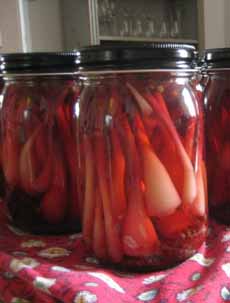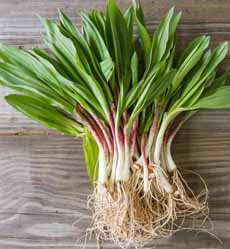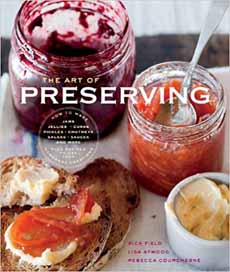SPRING RECIPE: Pickled Ramps
 [1] Head to the farmers market to pick up wild ramps. Or, if you live in the eastern U.S. near mountains, pick your own. They grow in rich, moist, deciduous forests, from North Carolina and Tennessee as far north as Canada; and west to Missouri and Minnesota (photo courtesy Rick’s Picks).
|
Spring is ramps season, the time to celebrate these rare wild members of the onion family, available for a few fleeting weeks each year. The flavor is a combination of spring onions and garlic.
Ramps are wild leeks, also known as ramson, wild garlic and wood leeks. In French, they are called ail des bois, garlic of the woods, because they grown in forests in the eastern U.S. Some seeds are blown into fields and even backyards. The leaves (tops) and bulbs can be eaten in their entirety, like green onions a.k.a. scallions (the different types of onions). Use the tops in salads, on burgers and sandwiches; cook them in egg scrambles, omelets (recipe) and stir-fries, add them wherever you’d use green onions (scallions). How about scallion pancakes? You can do the same with pickled ramps (recipe below); plus, add them to an antipasto platter, cheese or crudités plate and replace the olives in a Martini. Check your local farmers market and scoop them up while you can. (Or, if you live in the eastern U.S. near mountains, check for local opportunities to pick your own. Or, grow your own.) You can also pickle them with the recipe below, from Rick’s Picks, our favorite pickle maker (we always send gift packs of assorted pickled vegetables to pickle lovers). Here’s more about ramps, including how they differ from garlic scapes. This recipe uses Mason jars and a canning rack. If you don’t have the equipment but know someone who does, ask if you can borrow it; or even suggest that you pickle together and split the bounty. The hibiscus flowers provide a slight pink hue to the naturally white ramp bulbs; but if you can’t find them, don’t worry. If you like pickling and want to do more of it, get a copy of The Art of Preserving, co-authored by Rick’s Picks founder Rick Fields. Ingredients 1. FILL a large pot with 6” of water and bring to a boil. 2. PLACE six wide mouth pint Mason jars and their two-piece lids in a canning rack and immerse in the boiling water for 15 minutes. Alternative: you can run the jars and lids through a dishwasher cycle. |
|
|
3. REMOVE the canning rack and set it on a clean dish towel. 4. COMBINE the water, vinegar and salt in a large pot and set the heat to simmer. 5. TRIM the root ends off the ramps, rinse thoroughly and trim the tops so that you have 4-inch pieces of ramps. Save the tops for salads, eggs, etc. 6. SET the Mason jars on a clean surface. Place two dried hibiscus flowers in each jar. 7. CRUSH the pink peppercorns with a mortar and pestle or grind them lightly in a spice grinder. Put a teaspoon in each jar. Fill each jar snuggly with the ramps, about 5-6 ounces per jar. 8. BRING the brine pot to a boil, and using a glass measuring cup, fill the jars with boiling brine up to the fill line on the jars (the line will be 4” from the bottom of the jar). Make sure that the ramps are completely covered with brine. 9. SCREW the lids on tightly, being careful not to over over-tighten. Place the jars in the canning rack, using a jar lifter, and gently immerse the rack in the boiling water. Set a timer for 5 minutes. 10. REMOVE the rack and set the jars on a clean towel. Allow them to cool, undisturbed, for 24 hours. STORE in a cool dry place for two weeks before eating, to allow the flavors to fully develop. The ramps will be delicious for up to a year.
|
||




